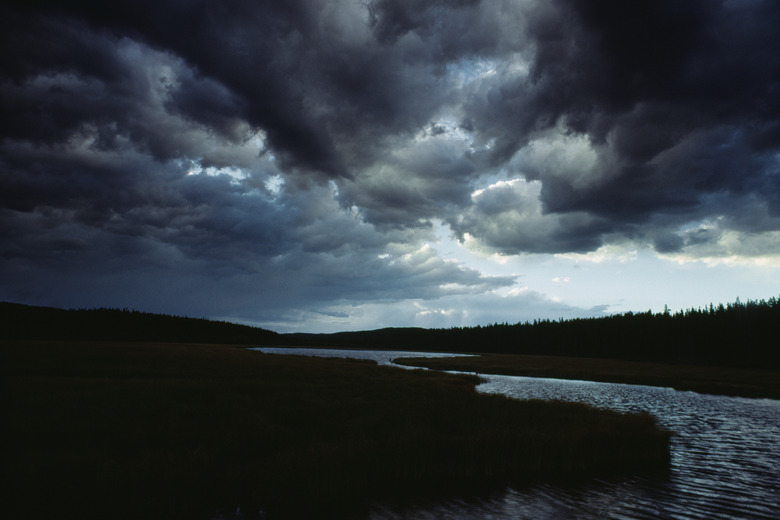Compare & Contrast High- & Low-Pressure Systems
If you've ever tuned into the weather channel, you might have heard the term 'pressure' thrown around. High and low pressure impact the type of weather you might experience and help meteorologists – the scientists who study weather patterns – determine your weather forecast. But what exactly is the difference between low pressure and high pressure? What does 'pressure' mean when discussing the weather?
What Is Atmospheric Pressure?
What Is Atmospheric Pressure?
When you step outside and take a deep breath of fresh air, you probably don't feel much pressure bearing down on you from the sky. Air doesn't exactly seem like a 'heavy' element. However, the atmosphere contains many different types of gases all stacked together, and those gases exert pressure. Though you might not be able to feel that pressure, the layers of gas in the atmosphere exert nearly 15 pounds of pressure on your body!
The amount of air pressure in any given location on earth isn't the exact same. Air pressure varies based on where you are, and different areas have different air pressure levels. This results in high and low pressure systems and impacts the weather in a region.
Low Pressure System Characteristics
Low Pressure System Characteristics
When you see a weather forecast, you might see the standard low pressure system symbol – a red 'L.' Meteorologists use this symbol to indicate an area with lower air pressure than the surrounding regions. In a low pressure system, the air has a lower density than the surrounding regions. The higher density air around the low pressure system moves into the area of lower pressure, resulting in a suction-like effect with the air rising in the center.
Typically, low pressure system characteristics involve undesirable weather. High winds, storms and even hurricanes are associated with low pressure systems. These types of systems can also result in a low pressure front where a mass of lower-pressure warm air meets a mass of higher-pressure cold air.
High Pressure System Characteristics
High Pressure System Characteristics
Where a low pressure system sucks air towards it, a high pressure system pushes air away from it into regions with lower air density. The air above these systems sinks towards the center, and the winds push outwards. High pressure system characteristics generally include desirable weather and clear skies. Weather forecasts use a blue 'H' to represent high pressure systems in their forecasts.
High Pressure System vs. Low Pressure System
High Pressure System vs. Low Pressure System
High pressure systems and low pressure systems have a few important distinctions. A high pressure system and a low pressure system produce different weather conditions. High pressure systems typically result in clear skies, light winds and fair conditions. In contrast, low pressure systems often result in cloudy skies, heavier winds and sometimes also result in stormy weather. For example, all hurricanes have low air pressure in the center, or eye, of the storm.
In the high pressure system vs. low pressure system equation, air direction also factors into the difference between the two types of systems. The air in the center of a high pressure system sinks towards the ground and moves outward. In a low pressure system, the air in the center raises upward and the surrounding air moves inward towards the center of the system.
The direction the air circulates also differs based on the system and the hemisphere. In the Northern Hemisphere, the air flows clockwise in high pressure systems and counter-clockwise in low pressure systems. The reverse occurs in the Southern Hemisphere.
In the Southern Hemisphere, high pressure systems move counter-clockwise and low pressure systems move in a clockwise direction. This phenomenon occurs due to the rotation of the earth, known as the Coriolis Effect.
References
- National Oceanic and Atmospheric Administration: What are High and Low Pressure Systems?
- University Corporation for Atmospheric Research: Center for Science Education: The Highs and Lows of Air Pressure
- Seattle Pi: Compare and Contrast High and Low Pressure Systems
- Weather Wiz Kids: Weather Forecasting
- National Oceanic and Atmospheric Administration – National Weather Service: Basic Discussion on Pressure
Cite This Article
MLA
Zinni, Yasmin. "Compare & Contrast High- & Low-Pressure Systems" sciencing.com, https://www.sciencing.com/compare-contrast-high-lowpressure-systems-17774/. 30 September 2021.
APA
Zinni, Yasmin. (2021, September 30). Compare & Contrast High- & Low-Pressure Systems. sciencing.com. Retrieved from https://www.sciencing.com/compare-contrast-high-lowpressure-systems-17774/
Chicago
Zinni, Yasmin. Compare & Contrast High- & Low-Pressure Systems last modified March 24, 2022. https://www.sciencing.com/compare-contrast-high-lowpressure-systems-17774/
